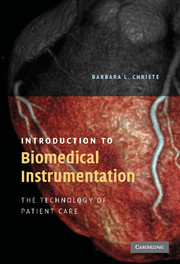Book contents
- Frontmatter
- Contents
- Preface
- INTRODUCTION TO BIOMEDICAL INSTRUMENTATION
- 1 BMET as a career
- 2 Patient safety
- 3 In the workplace
- 4 Electrodes, sensors, signals, and noise
- 5 The heart
- 6 Cardiac assist devices
- 7 Blood pressure
- 8 Respiration and respiratory therapy
- 9 The brain and its activity
- 10 The intensive care unit
- 11 The operating room
- 12 Imaging
- 13 Clinical laboratory equipment
- 14 Intravenous pumps and other pumps
- 15 Miscellaneous devices and topics
- Index
6 - Cardiac assist devices
- Frontmatter
- Contents
- Preface
- INTRODUCTION TO BIOMEDICAL INSTRUMENTATION
- 1 BMET as a career
- 2 Patient safety
- 3 In the workplace
- 4 Electrodes, sensors, signals, and noise
- 5 The heart
- 6 Cardiac assist devices
- 7 Blood pressure
- 8 Respiration and respiratory therapy
- 9 The brain and its activity
- 10 The intensive care unit
- 11 The operating room
- 12 Imaging
- 13 Clinical laboratory equipment
- 14 Intravenous pumps and other pumps
- 15 Miscellaneous devices and topics
- Index
Summary
LEARNING OBJECTIVES
1 describe defibrillator waveforms and characteristics
2 define the term AED and describe why it is useful
3 describe cardioversion
4 describe assistive technologies such as LVAD, pacemaker, implantable defibrillator, heart-lung bypass, ECMO, cardiac catheter, and IABP
Introduction
Technology is used to support heart function in numerous ways. Perhaps the most common and well-known device is the defibrillator. In addition, the amazing life-saving powers of artificial hearts and implantable devices capture the attention of the public and news media on occasion.
ACLS (advanced cardiac life support) is a detailed protocol to provide life-saving cardiac care. BMETs may be involved in the selection of technology and technical protocols used in a crisis. In addition, BMETs may help establish training programs and awareness for the technology involved in emergency response.
Defibrillators
A defibrillator, which is often used in life-saving moments on television medical shows, is a fairly simple device that delivers a large amount of energy across a patient's chest when the heart is not beating properly. When the heart is not beating with a pattern, all cells are contracting at different times; this is known as fibrillation. Defibs (as they are often called) in use today send about 3,000 volts (V) – up to 20 amperes (A) – across a patient's chest. (Note: The amount of voltage and current vary tremendously based on the patient's size and therapeutic settings.) This large amount of energy causes all cells in the heart to depolarize at once.
- Type
- Chapter
- Information
- Introduction to Biomedical InstrumentationThe Technology of Patient Care, pp. 87 - 102Publisher: Cambridge University PressPrint publication year: 2009



